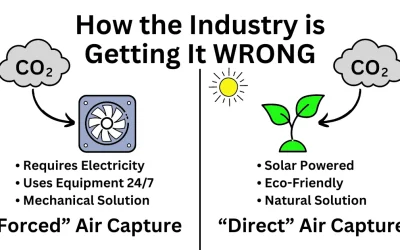In an era where the impact of climate change is becoming increasingly evident, the term ‘carbon sequestration’ is gaining paramount importance in our collective quest to mitigate environmental degradation. This guide aims to demystify the concept of carbon sequestration, offering a comprehensive understanding of its mechanisms, benefits, and significance in the modern world.
Understanding Carbon Sequestration
Carbon sequestration refers to the process of capturing and storing atmospheric carbon dioxide (CO2), one of the primary greenhouse gases contributing to global warming. This process is crucial in reducing the amount of CO2 in the atmosphere, thereby mitigating the effects of climate change.
Natural Methods of Carbon Sequestration
- Biological Carbon Sequestration: This natural process involves the absorption of CO2 by plants during photosynthesis. Forests, grasslands, and ocean phytoplankton play significant roles in this process. As plants absorb CO2, carbon is stored in plants, branches, leaves and roots.
- Soil Carbon Sequestration: This involves agricultural practices like no-till farming, cover cropping, and crop rotation, which enhance the carbon content in soil. Healthy soils have a higher capacity to store carbon, thus reducing atmospheric CO2 levels.
- Biochar: Biomass (like wood, manure, or agricultural waste) is heated to high temperatures in the absence of oxygen. This process transforms the biomass into a stable form of carbon, resistant to decomposition. The key feature of biochar is its incredibly porous structure, which increases soil fertility and helps in water retention, thus aiding agriculture.
- Wetland Restoration: Wetlands are significant carbon sinks. Restoring wetlands can enhance their capacity to store carbon in their soil and vegetation.
- Ocean-Based Sequestration: Methods like ocean fertilization (adding nutrients to stimulate phytoplankton growth) and restoring mangroves, seagrasses, and salt marshes can enhance oceanic carbon uptake.
Technological Methods of Carbon Sequestration
- Carbon Capture and Storage (CCS): This technology involves capturing CO2 emissions from sources like power plants and industrial facilities, and then transporting and storing it underground in geological formations. It’s a key strategy for reducing emissions from heavy industries.
- Direct Air Capture (DAC): DAC technologies actively remove CO2 directly from the atmosphere. The captured CO2 can then be stored or utilized in various products.
- Bioenergy with Carbon Capture and Storage (BECCS): This method combines biomass-based energy production with carbon capture and storage. When biomass (like wood or crop residues) is burned for energy, the CO2 produced is captured and stored, making the process carbon-negative.
- Enhanced Weathering: This involves spreading certain minerals that naturally react with CO2 and convert it into stable forms on land or in oceans. This method accelerates the natural weathering process, which is a slow, natural method of carbon sequestration.
- Carbon Mineralization: This process involves converting CO2 into solid minerals like carbonates. This stable form of carbon can be stored indefinitely without the risk of leaking back into the atmosphere.
The Role of Carbon Sequestration in Climate Change Mitigation
Carbon sequestration is a key component in the fight against climate change. By reducing the concentration of CO2 in the atmosphere, it helps in:
- Slowing Global Warming: Lower atmospheric CO2 levels mean less heat trapped on Earth, thus slowing the pace of global warming.
- Enhancing Biodiversity: Forests and oceans, as natural carbon sinks, support diverse ecosystems. Protecting these habitats is essential for biodiversity conservation.
- Improving Air Quality: Reducing CO2 emissions can lead to better air quality, benefiting public health.
Carbon Credits and Economic Incentives
The concept of carbon credits is intrinsically linked to carbon sequestration. A carbon credit represents a reduction of one metric ton of CO2 emissions. Businesses and industries can invest in carbon sequestration projects, earning carbon credits, which can then be traded or sold. This system incentivizes companies to reduce their carbon footprint, making carbon sequestration not only an environmental initiative but also an economic one.
Challenges and Future Directions
While carbon sequestration offers significant benefits, it also faces challenges, including:
- Technical and Economic Feasibility: The cost and technology involved in capturing and storing carbon, especially in geological sequestration.
- Monitoring and Verification: Ensuring the long-term storage and tracking of sequestered carbon is crucial for the effectiveness of these projects.
Conclusion: Embracing Plant-Based Solutions with Dynamic Carbon Credits
In the quest for a sustainable future, the role of carbon sequestration, especially through plant-based methods, is invaluable. Dynamic Carbon Credits leads the way in this innovative multi-modal approach, harnessing the power of nature to combat climate change. Their plant-based method focuses on capturing carbon near the source with a verifiable and repeatable method to sequester the carbon for the long term.
Dynamic Carbon Credits offers a unique opportunity for corporations to capture their carbon emissions with confidence. We employ a vetted process that involves multiple natural processes to provide a credible way to sequester your carbon emissions for the long term.
Take Action Today for a Greener Tomorrow
If you are considering options to sequester or offset carbon emissions, we are here to help. The journey begins with a conversation. Allow us to help you make an informed decision. The carbon credit markets and industry are evolving. There are bad actors in the market to avoid. You can take advantage of our years of research and implementation to avoid common pitfalls and develop a winning solution.
A short conversation can be the beginning of a greener future.





